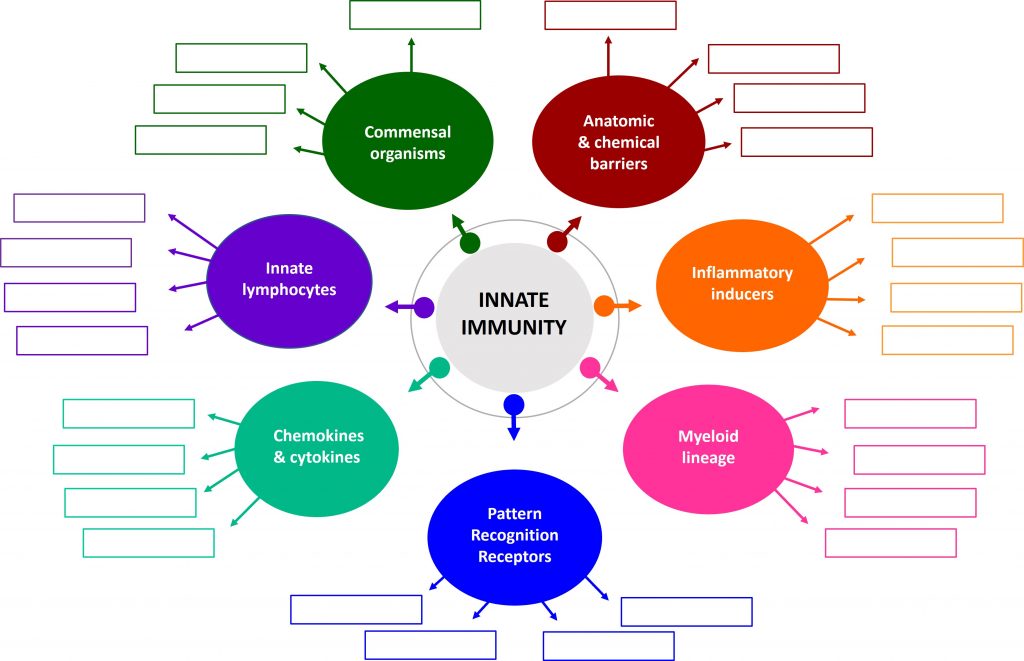Interactive mind map – creating bonds among new learners
Dr Malgorzata Trela and Dr Sophie Rutschmann

What is the idea?
Countless educational institutions welcome new students to their courses every year. Whether in a blended, face-to-face or hybrid learning approach, helping students get to know each other is a fundamental part of the induction programme because it contributes to community building and the sense of belonging (Smith et al., 2021). Establishing initial connections between peers and their tutors can be achieved via a variety of bonding activities. More than an icebreaker activity, where students typically learn some personal information about each other, the interactive mind map that we devised offers students the opportunity to get to know their peers by applying their newly acquired knowledge collaboratively in a safe space. Growing together into a team of curious and open-minded individuals, through this activity, the students can challenge ideas between each other and begin to lay the groundwork favouring peer learning for the remainder of their course. Moreover, it provides opportunities for peer knowledge transfer, facilitates collaboration amongst students and stimulates cohort discussion upon receipt of academic feedback on this activity from their tutor or lecturer, whose supportive role is very much that of a ‘guide on the side’ (King, 1993). This encourages students to be proactive and to appreciate the importance of collaborative learning (Cedros Araujo & Gadanidis, 2020; Poellhuber et al., 2008).
Why this idea?
It is quite apparent that students’ attitudes have an impact on their learning journey. Therefore, developing rapport and bonds among peers from the start can help to generate a positive atmosphere and mutual respect which encourage their participation in activities (Scager et al., 2016). This is grounded in the formation of a social context and team identity, both of which are important for collaborative learning (Adel, 2011). Students’ respect for, and recognition of the opinions of their tutors usually tends to be more apparent than that for their fellow classmates. The idea behind the interactive mind map has been developed with maximising bonding, the sense of fellowship and empathy at its centre. This field-specific interactive task promotes student-led learning by fostering comfortable interaction among team members and presents the opportunity to discover their peers’ ideas (which are often different to their own) by engaging in discussions (Zheng et al., 2020). In addition, through the visual organisation of information, a mind map enables learners to notice connections between various concepts and to appreciate the bigger picture within an area of interest (Davies, 2011; Rajapriya & Kumar, 2017; Wright, 2006). An example of a mind map is demonstrated in Figure 1.
How could others implement this idea?
The following guidelines were written for our Masters in Immunology programme, at Imperial College London, consisting of around 35 students divided into small groups of 5-6. They have been developed for online teaching, with the help of online breakout spaces, and can easily be adapted to a face-to-face setting.
The students are provided with a pre-selected coursework book chapter or publication which explores introductory concepts in the subject of interest. Several sources of information can be provided, however, since this is an icebreaker type of activity, one source is preferred in our context. Each group of students is allocated a specific theme, originating from the published source, which constitutes a segment of a bigger concept. This concept is communicated in an interactive editable document (such as a file accessed via a web page link) depicting the structure of a mind map with the main concept specified at its centre and surrounded by the individual colour-coded theme components (as per the image above).
In their respective groups, students are instructed to read the assigned section from the coursebook/publication, discuss the provided material and agree on four key points which the section is trying to communicate. These key points, together with a brief commentary summarising the importance of their theme, are listed by the student groups in the appropriate text boxes within the interactive mind map document. Students have 40 minutes to work in their teams to complete their section of the mind map. After the allocated time is up, students select a speaker (or a number of speakers) within their group who will briefly present the points that are included in their section to the rest of the class. Once all groups have completed their sections and presentations, a tutor provides feedback to the class. On completion of the task, a clear interdependence of all themes is demonstrated, and the developed mind map serves as a learning and revision material.
Transferability to different contexts
The approach is easily transferable to any programme which welcomes a cohort of new students where there is a need to create bonding opportunities including undergraduate, postgraduate and doctoral courses. It requires very little preparation from the tutor who only needs to create a mind map template, select the matter of interest from a published source, identify the sub-themes and assign them to the student groups. The tutor facilitates this task by monitoring students’ progress through active listening and can serve as an advisor if support is needed. Students are subsequently provided with feedback on their presentations during a synchronous session where they are able to reflect on the correlations between various elements of their mind map.
Links to tools and resources
Free online mind mapping tool: MindMup (https://www.mindmup.com/)
References
Adel, A. (2011). Rapport building in student group work. Journal of Pragmatics, 43(12), 2932-2947. https://doi.org/10.1016/j.pragma.2011.05.007
Cedros Araujo, R., & Gadanidis, G. (2020). Online collaborative mind mapping in a mathematics teacher education program: A study on student interaction and knowledge construction. ZDM Mathematics Education, 52(5), 943-958. https://doi.org/10.1007/s11858-019-01125-w
Davies, M. (2011). Concept mapping, mind mapping and argument mapping: what are the differences and do they matter? Higher Education, 62(3), 279–301. https://doi.org/10.1007/s10734-010-9387-6
King, A. (1993). From sage on the stage to guide on the side. College Teaching, 41(1), 30-35. https://doi.org/10.1080/87567555.1993.9926781
Poellhuber, B., Chomienne, M., & Karsenti, T. (2008). The effect of peer collaboration and collaborative learning on self-efficacy and persistence in a learner-paced continuous intake model. Journal of Distance Education, 22(3), 41-62.
Rajapriya, M., & Kumar, N. (2017). Effectiveness of mind mapping in higher education. International Journal of Civil Engineering and Technology, 8(4), 975-981.
Scager, K., Boonstra, J., Peeters, T., Vulperhorst, J., & Wiegant, F. (2016). Collaborative learning in higher education: Evoking positive interdependence. CBE Life Sciences Education, 15(4), ar69. https://doi.org/10.1187/cbe.16-07-0219
Smith, S., Pickford, R., Sinclair, G., Priestley, J., Sellers, R., & Edwards L. (2021). Building a sense of belonging in students: Using a participatory approach with staff to share academic practice. Journal of Perspectives in Applied Academic Practice. 9(1), 44-53. https://doi.org/10.14297/jpaap.v9i1.448
Wright, J. (2006). Teaching and assessing mind maps. Per Linguam. 22(1), 23-38. http://dx.doi.org/10.5785/22-1-59
Zheng, X., Johnson, E., & Zhou, C. (2020). A pilot study examining the impact of collaborative mind mapping strategy in a flipped classroom: learning, achievement, self-efficacy, motivation, and student’s acceptance. Educational Technology Research and Development, 68, 3527-3545. https://doi.org/10.1007/s11423-020-09868-0
Image attribution
Figure 1. Example of mind map activity by Malgorzata Trela is used under CC-BY 4.0 licence



